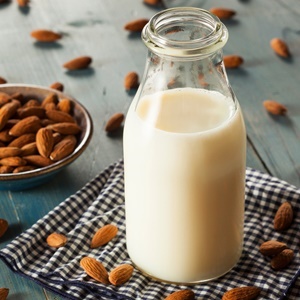(image: iStock)
Whether it’s because of a new diagnosis of lactose intolerance, an attempt clear away nasal congestion, or simply to cut down for health reasons… the move away from consuming dairy is becoming more mainstream than ever before.
No longer is it taboo to ask for a dairy-free cappuccino at your local coffee shop (and many establishments offer more than just soy milk!) but once you’ve made the decision to avoid dairy, for many it can be rather daunting – especially if you aren’t already familiar with some dairy alternatives.
There are a few things that you will need to look closely at when approaching these new ingredients – how much sugar does it contain? What is the fat percentage per 100ml? Are there nasty additives or GMO’s that you should know about? And lastly (probably the most crucial, if you ask me), are the taste and texture.
Here is a list of some common dairy alternatives that we think you might find useful.
1. Coconut milk
Mostly found in a can, you can use coconut milk in your coffee, in a smoothie, in ice creams and of course that delicious Asian curry you’ve seen on Food24 but never tried. Coconut milk carries a very strong coconut flavour (might seem obvious but it does) so be weary of just throwing it into everything.
Make it yourself: Blend 1 cup of unsweetened, dried coconut flakes with 2 cups of boiling water, leave for 5 hours for the flavour to develop and then strain.
Click here to see how to make cashew and coconut roasted banana ice cream
2. Rice milk
Rice milk is made of rice (duh) and can sometimes taste a bit grainy due to the bits of rice in it that haven’t been strained out. The milk itself is rather high in carbs and has a lower protein content than other dairy-free milks. The commercial varieties often have a thickener or starch added to give it some creaminess and make it last longer on the shelf.
Make it yourself: Boil 1 cup brown rice with 3 cups of water, 1 teaspoon cinnamon, and 1 teaspoon honey. Once the rice is cooked, blend it with 4 more cups of water. Strain with a fine sieve.
3. Oat milk
Since oat milk is nut-free as well as dairy-free, it’s a good choice for those who are prone to nut and dairy allergies. You can buy oat milk in some supermarkets in South Africa although it will have a few preservatives. Oat milk is one of the most nutritious options with its good dose of vitamin A and iron. It’s also cheap to make and you can use the leftover pulp in baked goods.
Make it yourself: Soak 1 cup of oats with 3 cups of water for 8 hours. Blend this with 2 more cups of water and add a tsp of salt and 1 tsp honey. Blend for until smooth and strain through a fine sieve.
4. Nut milk (think almond, hazelnut, cashew)
Probably the most popular dairy alternative at the moment with almond milk being the favourite. You can find almond milk in most good supermarkets as well as some coffee shops and restaurants. The unsweetened variety is obviously healthier with its main drawcard being that it’s free of cholesterol. It has a wonderful nutty flavour and is great in baked goods or as a warming night-time drink. Click here to find out how to make your own.
5. Soy milk
Soy has been scrutinized in the last few years for its reported levels of unhealthy hormones – phytoestrogens, which are plant compounds that the human body sees as estrogen. There are also claims that many of the soybeans that are produced for soy milk have been genetically modified. Many people would probably be surprised to know that soy milk contains almost as much protein as cow’s milk. The texture is much more watery though and it has beany, nutty taste.
ALSO READ: 10 recipes that might change your mind about veganism

